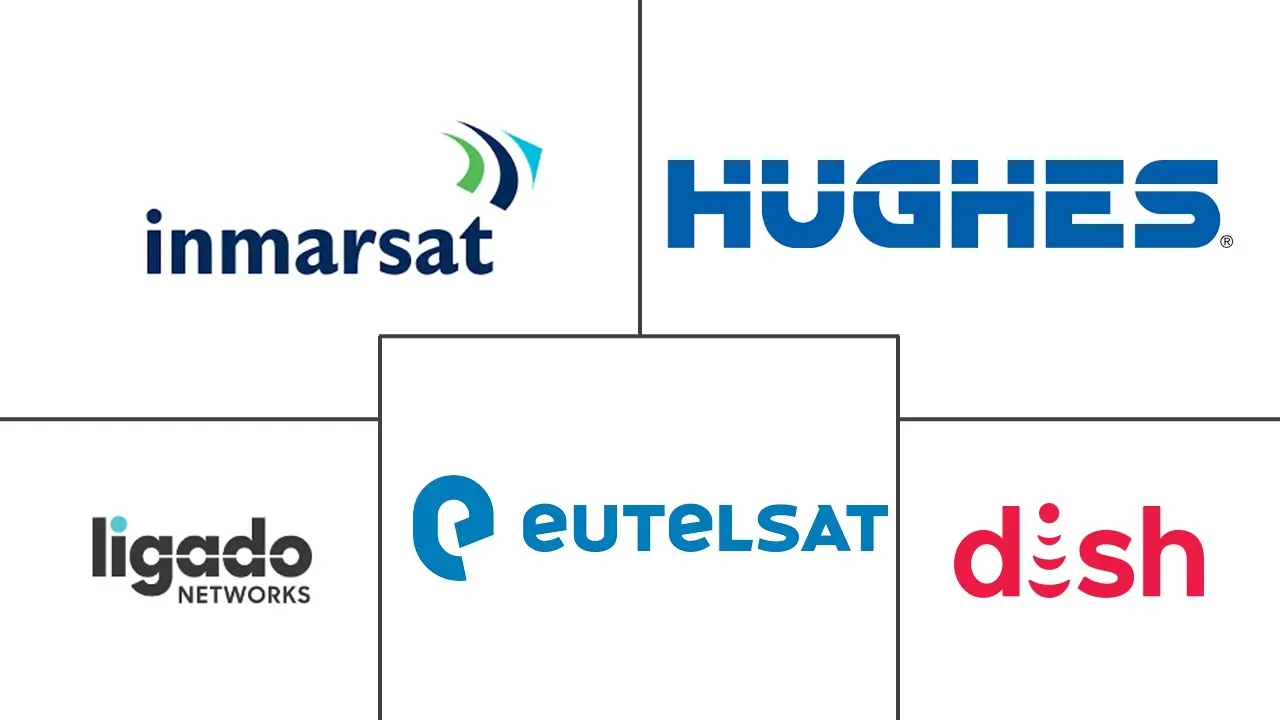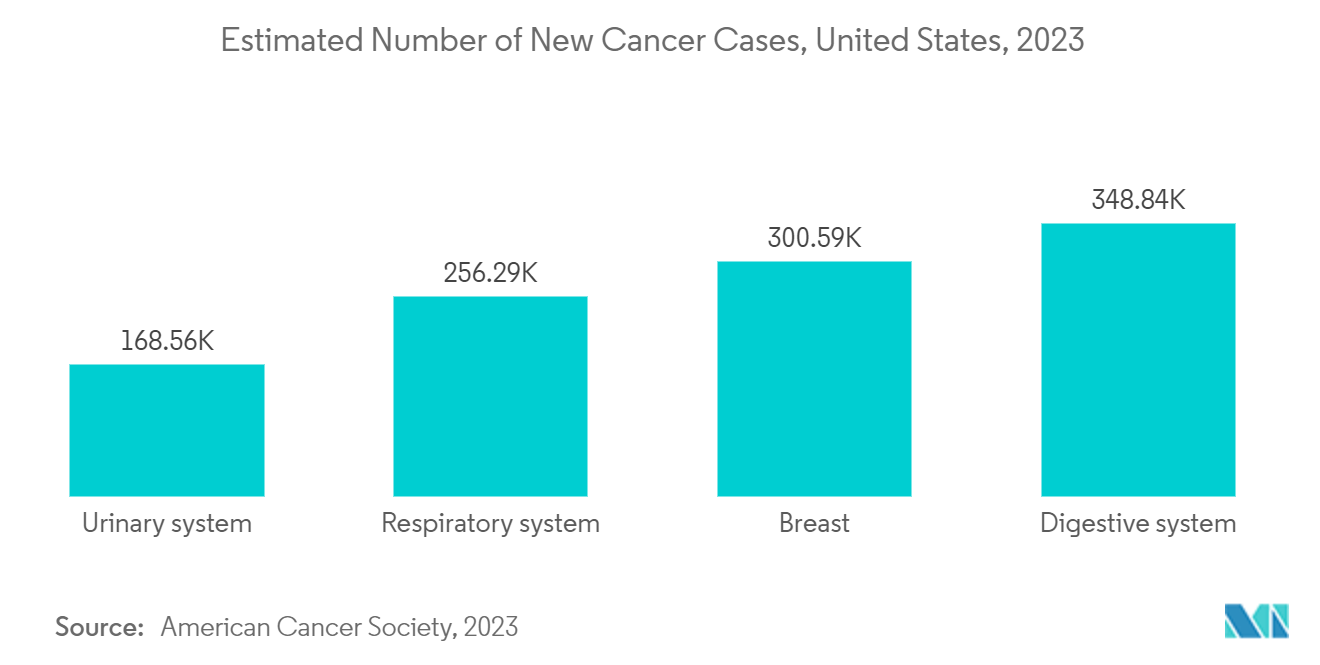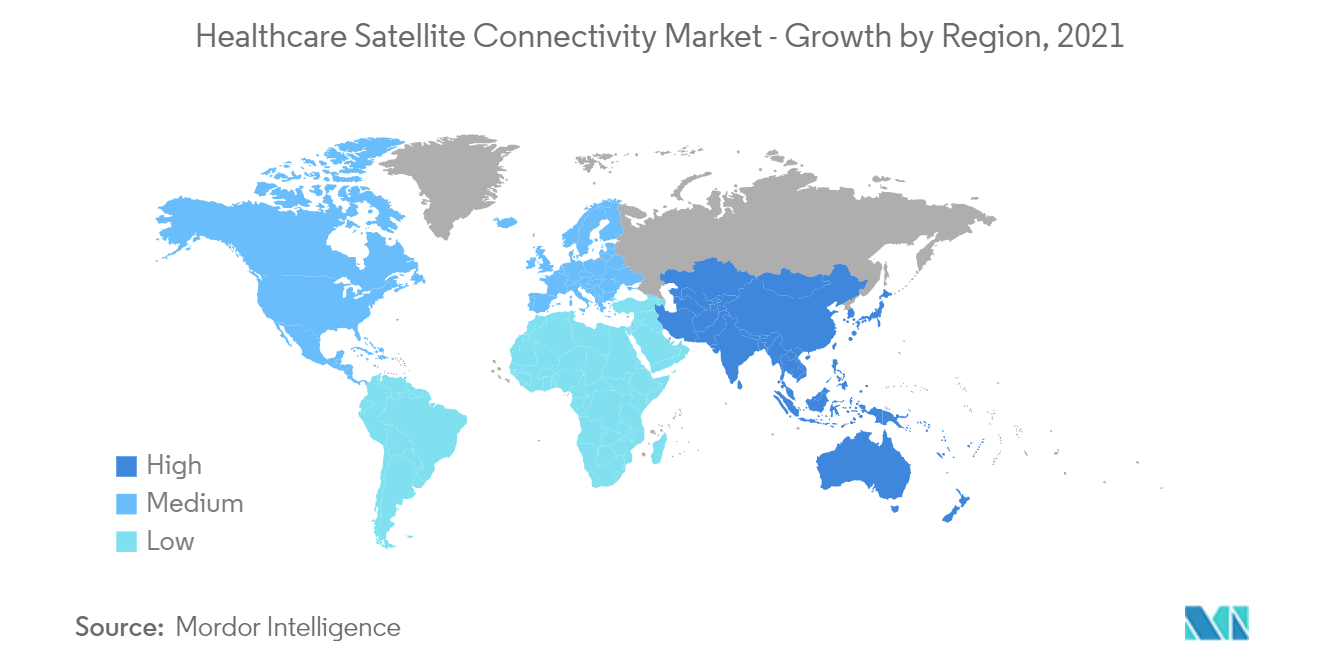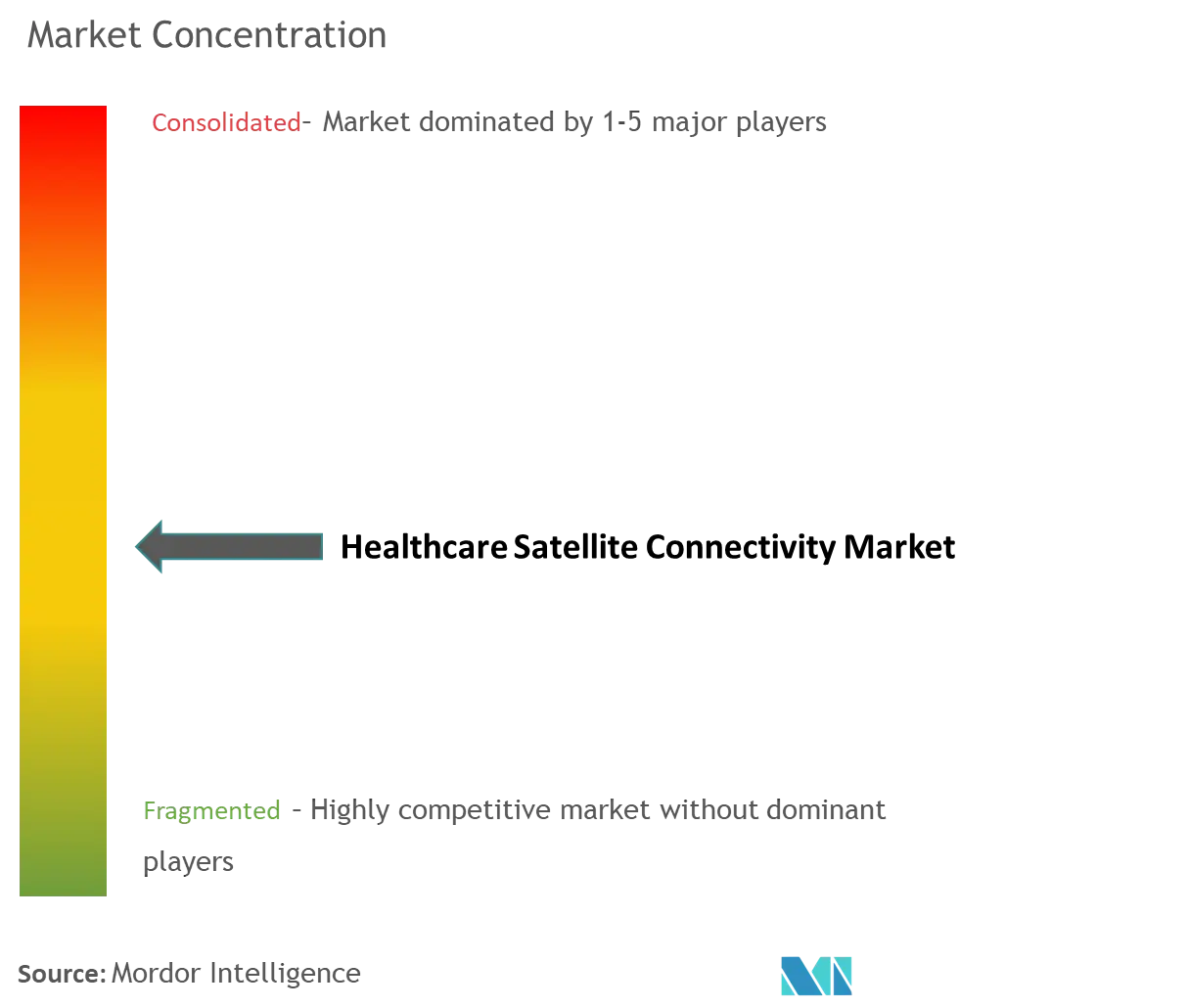Healthcare Satellite Connectivity Market Size

| Study Period | 2019 - 2029 |
| Market Size (2024) | USD 8.44 Billion |
| Market Size (2029) | USD 11.56 Billion |
| CAGR (2024 - 2029) | 6.50 % |
| Fastest Growing Market | Asia-Pacific |
| Largest Market | North America |
Major Players
*Disclaimer: Major Players sorted in no particular order |
Healthcare Satellite Connectivity Market Analysis
The Healthcare Satellite Connectivity Market size is estimated at USD 8.44 billion in 2024, and is expected to reach USD 11.56 billion by 2029, growing at a CAGR of 6.5% during the forecast period (2024-2029).
The COVID-19 pandemic significantly impacted various industries worldwide, including the healthcare and satellite connectivity markets. The pandemic acted as a catalyst for adopting and developing satellite connectivity solutions in the healthcare sector. The increased reliance on telemedicine, improved connectivity infrastructure, remote resource management, data exchange, and investment in satellite healthcare solutions have transformed the healthcare satellite connectivity market and are likely to have long-lasting effects beyond the pandemic. The need for remote healthcare services has surged with lockdowns, social distancing measures, and overwhelmed healthcare systems. Telemedicine, which relies on satellite connectivity to provide remote consultations and monitoring, has experienced a sharp rise in demand during the pandemic. Healthcare providers have increasingly turned to satellite technology to bridge the gap between patients and doctors, enabling virtual consultations, remote diagnostics, and patient monitoring. For instance, as per the article published by BioMed Central Ltd in September 2022, telemedicine has increased substantially, particularly for hospital-based in-patient services and in private clinics and ambulatory settings since the onset of the COVID-19 pandemic. Furthermore, as per the article published by Cureus in March 2023, patients sought telemedicine as advantageous and appropriate for providing healthcare services during the COVID-19 pandemic. As per the same source, the patients are more willing to try telemedicine, resulting in higher acceptability during the post-pandemic period. Therefore, looking at the overall scenario, the pandemic has increased the adoption of telemedicine healthcare satellite connectivity services and is expected to do the same during the forecast period.
The major factors responsible for the high market growth include rising healthcare expenditure toward developing eHealth, telemedicine, telehealth, and other mHealth solutions and increasing government initiatives for promoting and developing satellite connectivity.
In addition, the rising adoption of AI in telemedicine to improve patient healthcare outcomes is also projected to drive market growth during the forecast period. For instance, as per the article published by the Arizona Telemedicine Program in June 2022, in the recent few years, there has been an increase in the adoption of AI in telemedicine to allow doctors to make more data-driven, real-time decisions for the improvement of the health outcomes and patient experience by enabling them to work more toward virtual care alternatives throughout the care continuum. Therefore, with AI-integrated telemedicine, doctors and patients can communicate remotely via satellite internet for consultations, diagnoses, and distance surgeries, thereby increasing the market growth.
Furthermore, the rising government initiatives toward adopting healthcare satellite connectivity in healthcare are also projected to drive market growth during the forecast period. For instance, in March 2021, the Satellite telecommunications company and Luxembourg Government launched the second phase of the SATMED telemedicine project in 2024. SATMED is enabled by satellite and is designed to connect doctors and nurses from remote locations to the outside medical world, providing access to the platform's cloud applications for e-training, virtual consultations, management and storage of medical data records, and video conferencing.
Moreover, the rising product launches by prominent players are also burgeoning the market growth. For instance, in January 2023, Senet and Telli Health launched the first remote patient monitoring (RPM) hardware powered by LoRaWAN technology. LoRaWAN is an open protocol for designing low-power. These wide-area wireless telecommunication networks will allow providers to reach more patients in remote and underserved areas like indigenous communities worldwide, boosting healthcare equity and inclusivity.
Therefore, the rising adoption of AI-integrated telemedicine, various government initiatives, and an increasing number of product launches are projected to augment healthcare satellite connectivity market growth during the forecast period. However, bandwidth problems and low penetration of internet services in remote areas are expected to restrain the development of the studied market.
Healthcare Satellite Connectivity Market Trends
Telemedicine Segment is Expected to Hold Significant Share Over The Forecast Period
The combination of increased access to healthcare, improved connectivity, cost and time efficiency, demographic trends, and technological advancements are certain factors that are projected to drive the growth of the telemedicine segment in the healthcare satellite connectivity market.
In addition, the rising number of imaging procedures, the development of IT infrastructure, the rise in healthcare expenditure, and the increasing prevalence of osteoarthritis and chronic diseases are also increasing the segment growth. For instance, as per the article published by the American Cancer Society Journal in January 2022, approximately 1.9 million new cancer cases were projected to occur in the United States in 2022. The rising prevalence of chronic conditions, such as cancer, is increasing the diagnostic imaging procedural rate. Hence, the rising number of imaging procedures is projected to boost the demand for reliable and efficient teleradiology solutions, resulting in high growth in the market.
Additionally, the increasing healthcare expenditure is positively influencing the overall market growth. For instance, as per the National Health Expenditure Projections 2023-2024, growth rates in United States health expenditures are projected to be 5% and 5.1% throughout 2023 and 2024, respectively, as patient care patterns are assumed to revert to pre-pandemic levels. Telemedicine solutions have demonstrated the ability to enhance health outcomes and reduce costs. Telemedicine has been decreasing the cost of healthcare while increasing efficiency through improved management of chronic diseases, reduced travel times, and fewer and shorter hospital stays.
Moreover, the active participation of prominent players in the launch of various teleradiology platforms is also increasing the market growth. For instance, in August 2022, 5C Network launched its artificial intelligence-powered platform Prodigi to interpret radiology images directly from the cloud. This state-of-the-art platform enables teleradiology at a massive scale and makes it possible for diagnostic centers and hospitals to submit scans and access reports. Thus, such developments made by prominent players are projected to burgeon segment growth during the forecast period.
Therefore, due to the above-mentioned factors, the telemedicine segment in the healthcare satellite connectivity market is projected to grow significantly during the forecast period.

North America Region is Expected to Occupy a Major Share in the Healthcare Satellite Connectivity Market Over the Forecast Period
The geographical analysis of the healthcare satellite connectivity market shows that North America holds a significant market share in the global market. This is due to the rising number of Internet users, the increasing prevalence of chronic diseases, the well-developed healthcare infrastructure, and various strategies prominent regional players perform.
For instance, as per the data updated by the Center for Disease Control and Prevention (CDC) in December 2022, 6 in 10 adults in the United States currently have a chronic disease. The same source mentioned that approximately 4 in 10 adults in the country now suffer from two or more chronic conditions. Therefore, such a large proportion of people suffering from chronic diseases in the country is projected to create a massive demand for telemedicine services, thereby increasing the healthcare satellite connectivity market growth.
In addition, the increasing investments by government organizations in the region in various health sectors are also projected to increase market growth during the forecast period. For instance, as per the data updated by the National Institutes of Health (NIH), in March 2023, the United States healthcare expenditure in biomedical imaging rose from USD 2,774 million in 2021 to USD 3,101 million in 2022. Furthermore, rising agreements between prominent regional players drive market growth. For instance, in March 2023, Monogoto, the United States-based company, signed an agreement with Non-Terrestrial Network (NTN) service operator Skylo Technologies. This new agreement lowers developers' barriers to adding satellite connectivity to existing public and/or private networks already available on Monogoto Cloud. Monogoto's technology connects sensors and devices in the United States in the healthcare sector.
Therefore, due to the rising prevalence of chronic diseases, increasing healthcare expenditure, and various agreements, the regional market growth is projected to grow significantly during the forecast period.

Healthcare Satellite Connectivity Industry Overview
The healthcare satellite connectivity market is moderately competitive and consists of a small number of major players. In terms of market share, a small number of major players are currently dominating the market. However, with technological advancements and product innovations, mid-size to smaller companies are increasing their market by using new technologies. Major market players operating in the healthcare satellite connectivity market include Expedition Communications, Globalstar, SES S.A., Hughes, and Inmarsat Plc.
Healthcare Satellite Connectivity Market Leaders
-
Inmarsat Global Limited
-
Hughes Network Systems
-
Eutelsat S.A
-
DISH Network LLC
-
Ligado Networks
*Disclaimer: Major Players sorted in no particular order

Healthcare Satellite Connectivity Market News
- July 2022: Neom Tech and OneWeb agreed to a USD 200 million satellite network agreement. In the region where access to fiber-like Internet was previously unthinkable, Neom's ecosystem of cognitive technologies will transform companies and rural communities with OneWeb's Low Earth Orbit (LEO) satellite constellation.
- June 2022: Johnson & Johnson launched the J&J Satellite Center for Global Health Discovery (Satellite Center) at Singapore's Duke-NUS Medical School, jointly established by Duke University and the National University of Singapore (NUS).
Healthcare Satellite Connectivity Market Report - Table of Contents
1. INTRODUCTION
- 1.1 Study Assumptions and Market Definition
- 1.2 Scope of the Study
2. RESEARCH METHODOLOGY
3. EXECUTIVE SUMMARY
4. MARKET DYNAMICS
- 4.1 Market Overview
-
4.2 Market Drivers
- 4.2.1 Government Initiatives for Promotion and Development of Satellite Connectivity
- 4.2.2 Rising Adoption of eHealth
-
4.3 Market Restraints
- 4.3.1 Insufficient Penetration of Internet Services in Remote Areas
- 4.3.2 Bandwidth problems
-
4.4 Porter's Five Forces Analysis
- 4.4.1 Threat of New Entrants
- 4.4.2 Bargaining Power of Buyers/Consumers
- 4.4.3 Bargaining Power of Suppliers
- 4.4.4 Threat of Substitute Products
- 4.4.5 Intensity of Competitive Rivalry
5. MARKET SEGMENTATION (Market Size by Value - USD)
-
5.1 By Component
- 5.1.1 Medical Device
- 5.1.2 Software
- 5.1.3 Services
-
5.2 By Application
- 5.2.1 Telemedicine
- 5.2.2 Clinical Operations
- 5.2.3 Connected Imaging
-
5.3 By Connectivity
- 5.3.1 Mobile Satellite Services
- 5.3.2 Fixed Satellite Services
-
5.4 By End-User
- 5.4.1 Clinical Research Organization
- 5.4.2 Hospitals and Clinics
- 5.4.3 Research and Diagnostic Laboratories
- 5.4.4 Other End-Users
-
5.5 Geography
- 5.5.1 North America
- 5.5.1.1 United States
- 5.5.1.2 Canda
- 5.5.1.3 Mexico
- 5.5.2 Europe
- 5.5.2.1 Germany
- 5.5.2.2 France
- 5.5.2.3 United kingdom
- 5.5.2.4 Italy
- 5.5.2.5 Spain
- 5.5.2.6 Rest of Europe
- 5.5.3 Asia-Pacific
- 5.5.3.1 China
- 5.5.3.2 Japan
- 5.5.3.3 India
- 5.5.3.4 Australia
- 5.5.3.5 South Korea
- 5.5.3.6 Rest of Asia Pacific
- 5.5.4 Middle East and Africa
- 5.5.4.1 GCC
- 5.5.4.2 South Africa
- 5.5.4.3 Rest of Middle East and Africa
- 5.5.5 South America
- 5.5.5.1 Brazil
- 5.5.5.2 Argentina
- 5.5.5.3 Rest of South America
6. COMPETITIVE LANDSCAPE
-
6.1 Company Profiles
- 6.1.1 Inmarsat Global Limited
- 6.1.2 Hughes Network Systems, LLC
- 6.1.3 SES S.A.
- 6.1.4 X2NSat
- 6.1.5 Expedition Communications
- 6.1.6 Globalstar
- 6.1.7 Eutelsat Communications SA
- 6.1.8 AT&T Intellectual Property
- 6.1.9 DISH Network L.L.C.
- 6.1.10 Ligado Networks
- *List Not Exhaustive
7. MARKET OPPORTUNITIES AND FUTURE TRENDS
** Subject To AvailablityHealthcare Satellite Connectivity Industry Segmentation
Healthcare satellite connectivity helps to provide means for diagnosis and treatment virtually. It refers to using information and communication technology to enhance patient outcomes by increasing access to treatment and medical data.
The healthcare satellite connectivity market was segmented by component (medical device, software, and services), application (telemedicine, clinical operations, and connected imaging), connectivity (mobile satellite services and fixed satellite services), end-user (clinical research organization, hospitals and clinics, research and diagnostic laboratories, and others), and by geography (North America, Europe, Asia-Pacific, Middle East and Africa, and South America). The market report also covers the estimated market sizes and trends for 17 different countries across major regions globally.
The report offers the value (in USD) for the above segments.
| By Component | Medical Device | |
| Software | ||
| Services | ||
| By Application | Telemedicine | |
| Clinical Operations | ||
| Connected Imaging | ||
| By Connectivity | Mobile Satellite Services | |
| Fixed Satellite Services | ||
| By End-User | Clinical Research Organization | |
| Hospitals and Clinics | ||
| Research and Diagnostic Laboratories | ||
| Other End-Users | ||
| Geography | North America | United States |
| Canda | ||
| Mexico | ||
| Geography | Europe | Germany |
| France | ||
| United kingdom | ||
| Italy | ||
| Spain | ||
| Rest of Europe | ||
| Geography | Asia-Pacific | China |
| Japan | ||
| India | ||
| Australia | ||
| South Korea | ||
| Rest of Asia Pacific | ||
| Geography | Middle East and Africa | GCC |
| South Africa | ||
| Rest of Middle East and Africa | ||
| Geography | South America | Brazil |
| Argentina | ||
| Rest of South America |
Healthcare Satellite Connectivity Market Research FAQs
How big is the Healthcare Satellite Connectivity Market?
The Healthcare Satellite Connectivity Market size is expected to reach USD 8.44 billion in 2024 and grow at a CAGR of 6.5% to reach USD 11.56 billion by 2029.
What is the current Healthcare Satellite Connectivity Market size?
In 2024, the Healthcare Satellite Connectivity Market size is expected to reach USD 8.44 billion.
Who are the key players in Healthcare Satellite Connectivity Market?
Inmarsat Global Limited, Hughes Network Systems, Eutelsat S.A, DISH Network LLC and Ligado Networks are the major companies operating in the Healthcare Satellite Connectivity Market.
Which is the fastest growing region in Healthcare Satellite Connectivity Market?
Asia-Pacific is estimated to grow at the highest CAGR over the forecast period (2024-2029).
Which region has the biggest share in Healthcare Satellite Connectivity Market?
In 2024, the North America accounts for the largest market share in Healthcare Satellite Connectivity Market.
What years does this Healthcare Satellite Connectivity Market cover, and what was the market size in 2023?
In 2023, the Healthcare Satellite Connectivity Market size was estimated at USD 7.89 billion. The report covers the Healthcare Satellite Connectivity Market historical market size for years: 2019, 2020, 2021, 2022 and 2023. The report also forecasts the Healthcare Satellite Connectivity Market size for years: 2024, 2025, 2026, 2027, 2028 and 2029.
Healthcare Satellite Connectivity Industry Report
Statistics for the 2024 Healthcare Satellite Connectivity market share, size and revenue growth rate, created by Mordor Intelligence™ Industry Reports. Healthcare Satellite Connectivity analysis includes a market forecast outlook 2029 and historical overview. Get a sample of this industry analysis as a free report PDF download.



